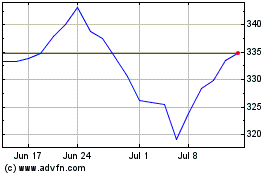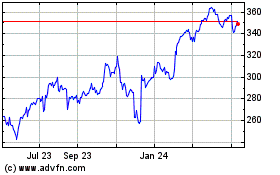Cigna Outlines Steps to Help Curb National Drug Epidemic
May 19 2016 - 8:05AM
Business Wire
- Commits to reducing opioid use among
customers by 25 percent in 3 years
- Treats substance use disorder as a
chronic disease
- Promotes efforts to reduce stigma
toward those with substance use disorders
Cigna today outlined steps to curb the country’s opioid
epidemic, starting with cutting the use of those drugs among its
own customers by 25 percent over three years.
Drug overdose is the leading cause of accidental death in the
U.S., with 47,055 lethal drug overdoses in 2014. Opioid addiction
is driving this epidemic, with 18,893 overdose deaths related to
prescription pain relievers, and 10,574 overdose deaths related to
heroin in 2014.* The Centers for Disease Control (CDC) and
Prevention reports that use of narcotic painkillers has quadrupled
in the past 10 years.
“To respond to this crisis, all stakeholders — patients,
physicians and other providers, pharmaceutical manufacturers and
distributors, payers, pharmacists and governments — must join
together to prevent substance use disorders, and assure access to
all appropriate treatments,” said David M. Cordani, president and
CEO of Cigna.
Cigna is committed to eliminating the stigma associated with
substance use so that people will seek the help they need – and
recognizes that for many, substance use disorder is a chronic
disease such as diabetes. The company is taking immediate action in
prevention and treatment:
- Reducing its customers’ opioid use by
25 percent – which would return to 2006 levels, before the drug
crisis. To achieve this goal, Cigna will tap into its extensive
experience with prevention, wellness and chronic disease management
programs, and will work with clients, physicians and others to
develop ways to increase prevention and treatment of substance use
disorders.
- Encouraging the rapid adoption of the
new CDC guidelines on opioid use, prescribing opioids for the
shortest time possible to treat acute pain, and talking with
patients about all options and risks before beginning long-term
therapy. Further, Cigna is supporting efforts to require
prescribers to check state Prescription Drug Management Program
databases when prescribing more than a 21-day supply of a
painkiller such as oxycodone or morphine.
- Limiting the quantity of painkillers
when appropriate, and exploring additional controls for high-risk
customers identified by Cigna's data on its customers. Cigna
continually enhances its tracking programs to flag possible
inappropriate use and to inform prescribers when an issue is
identified.
- Treating substance use like other
chronic diseases – holistically and using an evidence-based
approach. Cigna is working with its network to ensure
medication-assisted therapy – which combines behavioral therapy and
medications to treat substance use disorders – is readily available
and provided as part of a comprehensive treatment program. Cigna
also supports efforts by the Administration and Congress to
increase the patient limit for qualified physicians who prescribe
buprenorphine, which will make medication-assisted therapy more
accessible.
- Heightening awareness about the nature
of substance use disorders, calling on the public to embrace a new
view of substance use disorder as a chronic disease – and to not
blame the patient if she or he has a relapse.
- Calling on the rest of the health
insurance industry to join Cigna in the fight against this deadly
disease, and to take similar steps to immediately reduce deaths
from opioids.
Cigna's plan follows on the heels of its sponsorship of the May
4 Washington Post forum, “Addiction in America” at which Cordani
said, “Addiction afflicts our friends and families, colleagues and
communities. This is nothing less than a national tragedy – and a
continued failure to address it will constitute a national
failure.”
Earlier this month, Cigna also announced its collaboration with
the American Society of Addiction Medicine, in which Cigna
furnished customer claims data to ASAM to test and validate three
performance measures related to addiction treatment. The goal is to
verify what works in the treatment of patients with addiction, make
the medical community aware of proven strategies, and hasten the
adoption of these successful methods.
Last year, Cigna Foundation provided a $100,000 World of
Difference grant to Shatterproof, a non-profit organization
committed to ending addiction, and gave $50,000 to make naloxone –
a life-saving drug that reverses the effects of a drug overdose –
available for use by first responders in Pennsylvania. Cigna also
works with Stamp Out Stigma, an initiative spearheaded by the
Association for Behavioral Health and Wellness, to change
perceptions and reduce the stigma of mental illness and substance
use.
For more information on Cigna's leadership in addressing the
country’s drug crisis, go to Substance Use Disorder.
* Centers for Disease Control and Prevention, National Center
for Health Statistics, National Vital Statistics System, Mortality
File. (2015). Number and Age-Adjusted Rates of Drug-poisoning
Deaths Involving Opioid Analgesics and Heroin: United States,
2000–2014. Atlanta, GA: Center for Disease Control and
Prevention.
About Cigna
Cigna Corporation (NYSE: CI) is a global health service company
dedicated to helping people improve their health, well-being and
sense of security. All products and services are provided
exclusively by or through operating subsidiaries of Cigna
Corporation, including Connecticut General Life Insurance Company,
Cigna Health and Life Insurance Company, Life Insurance Company of
North America and Cigna Life Insurance Company of New York. Such
products and services include an integrated suite of health
services, such as medical, dental, behavioral health, pharmacy,
vision, supplemental benefits, and other related products including
group life, accident and disability insurance. Cigna maintains
sales capability in 30 countries and jurisdictions, and has more
than 90 million customer relationships throughout the world. To
learn more about Cigna®, including links to follow us on Facebook
or Twitter, visit www.cigna.com.
View source
version on businesswire.com: http://www.businesswire.com/news/home/20160519005703/en/
Cigna CorporationGloria Barone,
215-761-4758gloria.barone@cigna.com
Cigna (NYSE:CI)
Historical Stock Chart
From Mar 2024 to Apr 2024

Cigna (NYSE:CI)
Historical Stock Chart
From Apr 2023 to Apr 2024
